Meteors
The Quadrantids are the major shower of January and can be fairly numerous in ZHR, yet rather muted brightness-wise in comparison with the major showers of the year. The Quadrantids emanate from the northern polar region of the sky around Bootes, Draco and Hercules, in an area of sky which used to contain the now-defunct constellation of Quadrans Muralis (the mural quadrant). Possibly seeded by Minor Planet 2003 EH1, which may well be an extinct comet (first observed by Chinese astronomers around 500CE), the Quadrantids are numerous at their peak, sometimes reaching a Zenithal Hourly Rate in excess of 200 (though not all of these will be seen from a given location). This year, the peak date of the Quadrantids - January 3rd/4th - coincides with a nearly last quarter Moon, which rising at just before midnight GMT (from 51 degrees N), will rather spoil the opportunity for later observations, sitting in Virgo and not setting until just after 11.30am (GMT) on the 4th. However, earlier evening observations will be unencumbered by extraneous moonlight - so this is the time to aim observations for.
The Quadrantids sometimes peak with major storms, but the cloud of debris from which it is seeded is often perturbed by the passage of the major planets, which can't be easily predicted. This year’s shower is predicted to be somewhat less in terms of peak ZHR - probably around 120. Time your observing before moonrise and you should see a decent showing though.
Deep Sky Delights in Monoceros, Canis Major and Minor
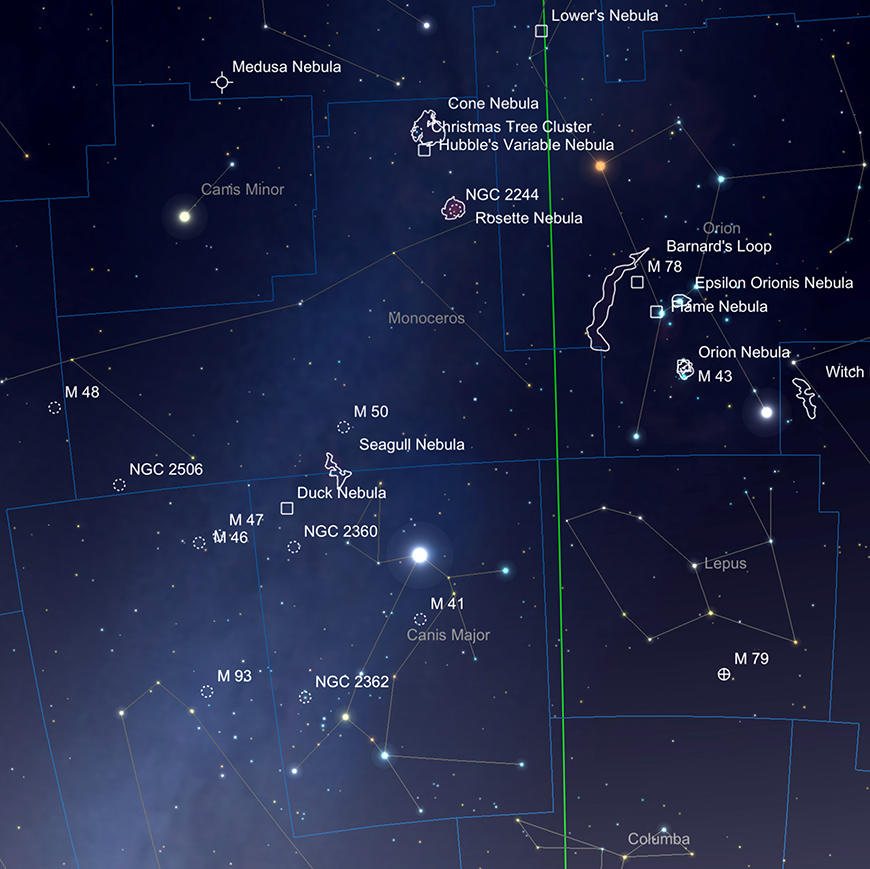
Canis Minor, Monoceros and Canis Major. Image created with SkySafari 5 for Mac OS X, ©2010-2016 Simulation Curriculum Corp., skysafariastronomy.com.
This month we ramble the stretch of sky that runs from the southern borders of Zodiacal constellation of Gemini, down into the reaches of Canis Minor and Monoceros and onwards further south into the larger of the two sky dogs, Canis Major (home of the brightest star in the sky, bar the Sun, Sirius).
Canis Minor, the Little Dog is a compact constellation, notable for its bright star Procyon, which at +0.34 mag is the 8th brightest star in the sky. Procyon is notable as one of the nearest stars to our own solar system, sitting some 11.4 light years away - making it our 14th closest stellar neighbour. Procyon is a binary star, whose constituents are the main A star, a white main sequence star of spectral type F5 and a companion, B, which is a white dwarf (type DA). This companion is a very difficult star to observe, but perturbations in observations of A's proper motion gave it away in 1840 - and by 1861 its orbit had been worked out, yet visual confirmation of B had to wait until a little later. Procyon B was finally observed in 1896 by the Lick 36-Inch Refractor. It remains a very difficult object to observe, even in large telescopes, as its angular separation with the primary star is so small. This and the difference in brightness +0.4 mag for A +10.8 mag for B, mean it is rarely seen and requires exceptional conditions to even attempt. The two stars are currently separated by 3.9 arc seconds, which roughly approximates to 15 AU actual separation - roughly the distance from the Sun to Uranus.
Procyon is a compound of the Greek for "preceding the dog" - the root meaning of this name comes from the fact that this star was observed to rise just before Sirius, or Canis Major and had great significance to ancient observers because of this. Ancient Arab myth saw the two main stars of both constellations as sisters, the elder of which, Sirius kept over the "river" of the Milky Way, which now runs between them. The younger of the Sisters, Procyon, was afraid and stayed on the original bank and wept. It was these tears that fed the celestial river of the Milky Way and eventually drained into the Nile, causing it to flood. The reappearance of both stars rising in the evening each year precedes this event - and thus the legend was born. Indeed, Beta Canis Minor, to be found to the NW of Procyon is named Gomeisa, which translates from the Arabic "little teary (or bleary) eyed one" - a literal link to this legend.
Moving in a westerly direction, across the constellation border into Monoceros, the Unicorn, we come to the beautiful Cone Nebula and Christmas Tree Cluster, NGC2264. The nature of the two objects and their relationship is problematic to define. The nebulosity's distance is sometimes put at 1000 light years hence, whereas the cluster is considerably further away at 2200 light years away (Clearly too far a distance removed to be easily defined as related), other sources but both objects being at 2700 light years away. Visually, it certainly looks as if the cluster is emerging from the nebulous region - if they are not related, they are doing a very good impression of being so! The two objects take up a large area - almost a Full Moon's width wide by two long (in actual fact the nebula extends much further but is largely invisible). Although listed as a bright object with the combined visual magnitude of +3.9 mag, large apertures and favourable observing conditions are needed to glimpse the nebulosity, though the cluster is easy enough with many instruments. The "Cone" feature of the nebula is to be found to the southerly end of the object and is a darker lane of gas and dust silhouetted against the brighter background nebula and star field. Long duration imaging is needed to see this feature well, as it can be difficult to detect visually. The Christmas Tree and the Cone were first noted by William Herschel in 1784 and 1785 respectively. The nebula, as noted, extends further and is also supposedly related to other objects in this area.
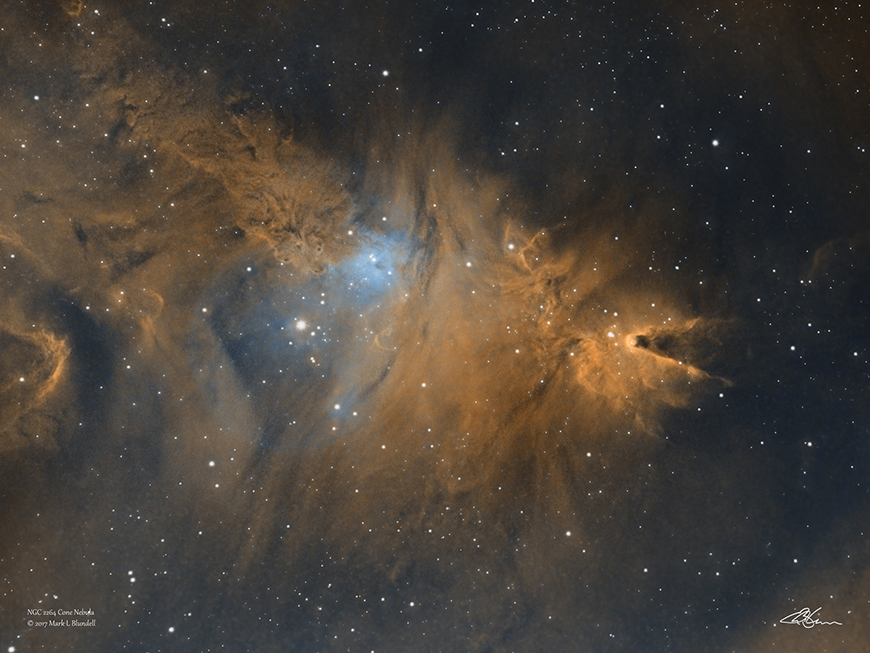
The Cone Nebula by Mark Blundell. Image used with kind permission.
One of these related objects lies a degree to the south of NGC2264 and is known as Hubble's Variable Nebula, or NGC261. This nebulosity was first discovered by Sir William Herschel in 1783 - its fan-shaped appearance making him think it to be a comet. Further observations showed it to be of a fixed position - this was no comet.
The nebula's surface area is reasonably bright, as it is a compact 4x2 arc minute in size and surrounds the star R Monocerotis, which is thought to be a T Tauri variable - unusual "Lithium burning" primitive stars, which have not yet started Hydrogen nuclear fusion in their cores - though the star itself is rarely directly observable. Although listed as +9.19 mag brightness officially, NGC2264 varies in brightness along with R Monocerotis, sometimes appearing two magnitudes difference over a matter of months. R Monoceros may be surrounded by a toroidal disk of dark material which frequently obscures the star's light. It is also likely that the star is accompanied by a smaller companion star, which my in turn be influencing the disk's orbit. The internal structure of NGC2264 has been noted to be changing rapidly, though this is best observed via the medium of astrophotography. The object holds the distinction of being the first object imaged by the groundbreaking 200-inch Hale Reflector, in 1949, by Edwin Hubble, who had been fascinated by this object throughout his astronomical career, previously studying it at Yerkes Observatory and through the 100-inch reflector at Mount Wilson.
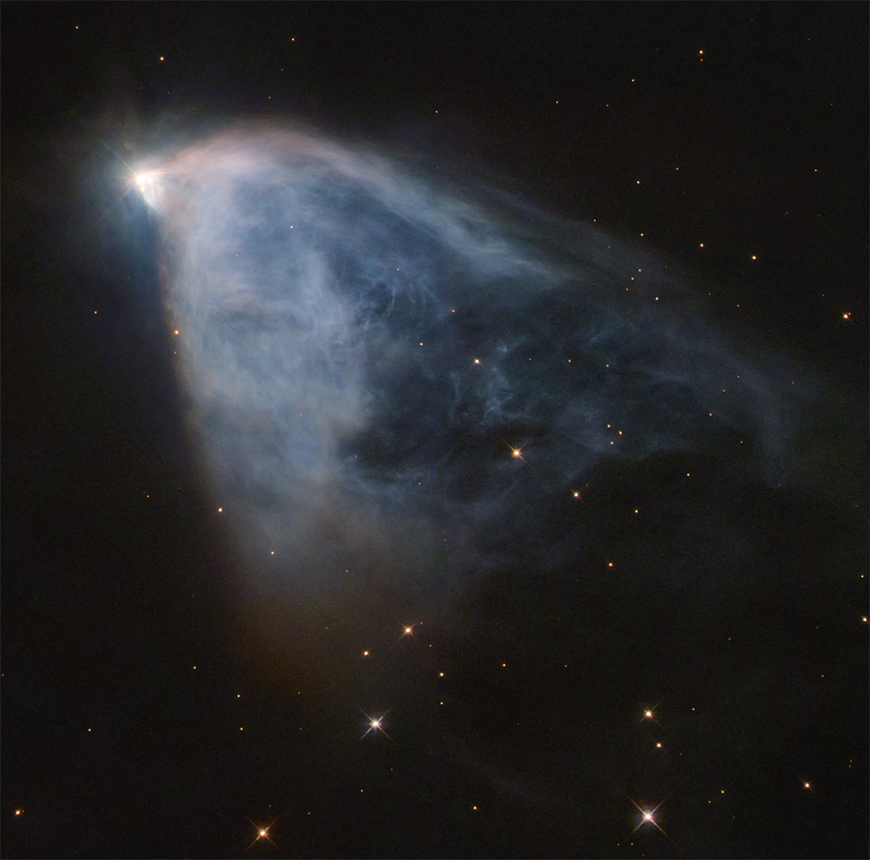
Hubble's Variable Nebula, HST Image (Judy Schmidt processed). Public Domain.
Hubble's Variable can be seen easily as a comet-like fan-shaped light patch in an 8-inch telescope. It is not impossible to observe the nebula with a smaller instrument when using a gentle LPR filter to boost contrast with background sky brightness, though it is suggested an observer keeps their magnification reasonably high to further aid this. Larger amateur instruments will be needed to see much of the internal structure. NGC2261 is thought to be around 2500 light years distance and occupies about 4-5 cubic light years
Four degrees south of NGC2261 is the spectacular Rosette Nebula and Cluster system, comprising NGCs 2237, 2238, 2239, 2244 and 2246. The Rosette's central cluster NGC2244 is easily seen in binoculars and small telescopes and is no challenge to larger instruments whatsoever - this was discovered by the first Astronomer Royal, John Flamsteed in the early 1690s. The nebulosity surrounding the cluster is slightly trickier and while it can be seen with larger binoculars from a very dark site, requires a larger instrument of the 8-inch + class to resolve well. Variations and the darker lanes in the nebulosity are best seen with more substantial telescopes, using filtration - UHC, OIII and H Beta Filters all help isolate differing areas of the Rosette. This nebulosity will also require a low power widefield eyepiece as the extent of the Rosette Nebula is huge: 80 x 60 arc minutes, over 5 times the area of the Full Moon. The nebulosity was first noted by 19th Century Astronomers John Herschel, Albert Marth and Lewis Swift. The Rosette's 30 light year wide central hole has been created by the solar wind from the stars of NGC2244, this wind has created compression fronts in the outer nebula, leading to the Rosette's radial petal-like appearance. Astrophotography will reveal the whole of the Rosette's structure and its deep pink and red colouration.
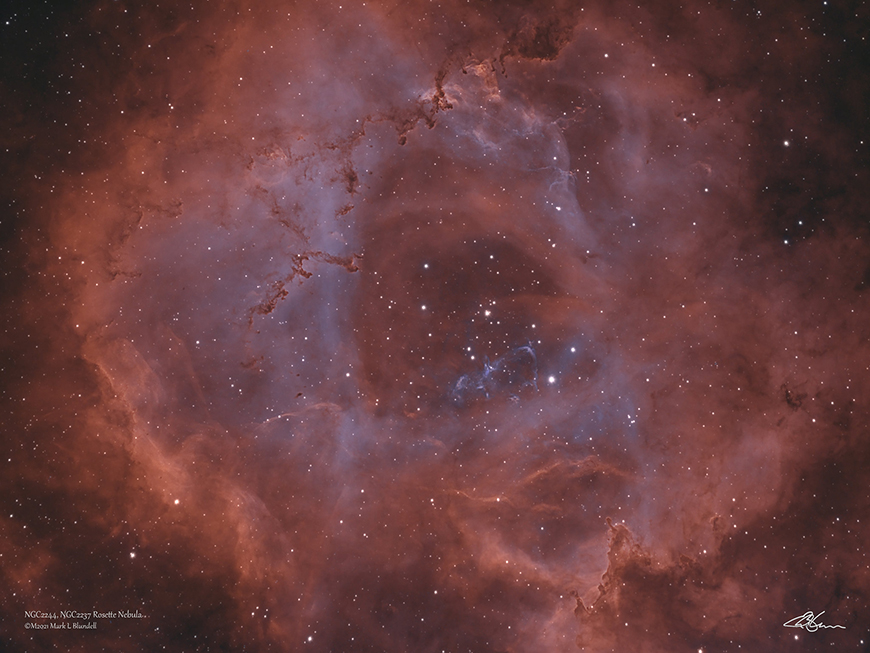
Rosette Nebula by Mark Blundell. Image used with kind permission.
Further south lie two interesting objects, the open cluster M50 and the Seagull Nebula. Cassini discovered M50 in 1710. It contains around 200 members and at +5.9 mag can be easily observed in binoculars and small telescopes. M50 contains mostly blue-white stars, many of which are arranged in attractive chains. The cluster is thought to be 3200 light years away and is around 78 million years of age.
The Seagull Nebula or NGC2327 straddles the Monoceros/Canis Major border. It is large and fairly faint at +10 mag, but can be observed in 8-inch+ instruments at low power, especially when coupled with H-Beta or UHC filters. Long duration astrophotography reveals the structure of the Seagull well - its large "wings" and "head" being especially prominent. The nebula itself is 2 degrees long by over a degree wide and also contains some smaller associated star clusters, the brightest of which is NGC2335, located at the northern extreme of the Seagull.
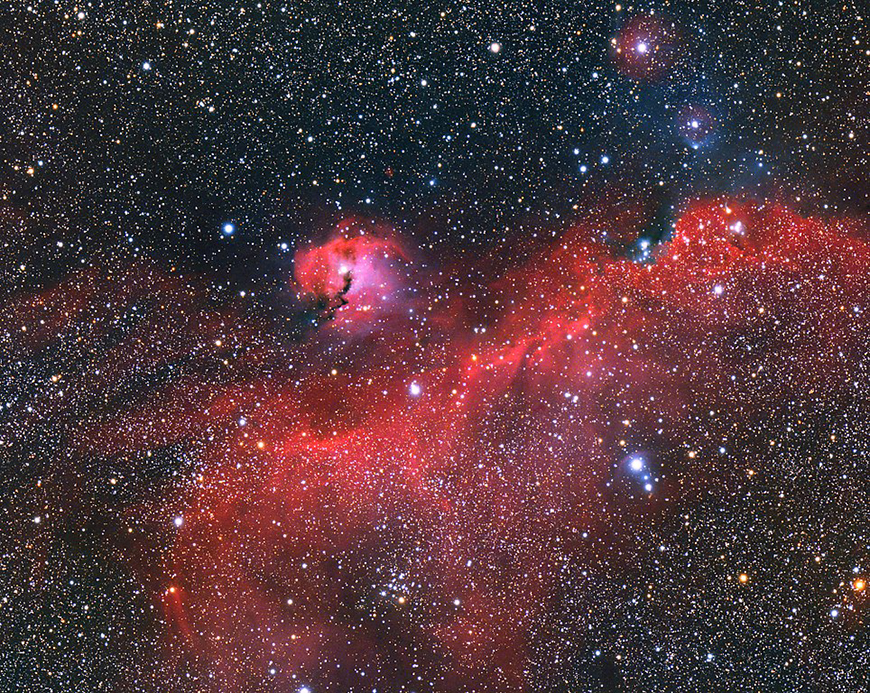
The Seagull Nebula. Image credit: Kees Scherer. Creative Commons.
The last object of note in Monoceros is NGC2506, a very reasonable triangle-shaped collection of around 150 observable stars. At +7.59 mag and being around the 12 arc minutes size, it is a pleasant-enough object to pick out in larger binoculars or a reasonable aperture of telescope. As a cluster, NGC2506 is rather old, being about 1.1 billion years of age, but hasn't as yet dispersed.
Hopping across the border into Canis Major, the larger of the two celestial dogs, we come to yet another excellent cluster, NGC2362. This cluster was discovered in the 1650s by the aforementioned Hodierna, who first catalogued it in 1654. At +4.1 mag, it is a bright object so it is uncertain how the likes of Messier and his collaborators managed to miss it. Sir William Herschel discovered it independently in 1783.
NGC2362 is a compact cluster - barely 5 arc minutes across, though it is reasonably numerous in population. We can see many of its 60 stars in amateur telescopes, though the most prominent of these by far is the star Tau Canis Majoris, which often gives this cluster it unofficial name. Tau CM is a very unusual star - a spectroscopic binary with obsoletely enormous components of spectral type O8. This system is thought to be amongst some of the largest and most luminous Supergiant stars known, with an absolute magnitude of -7. Lying some 5000 light years away, NGC2362 is very luminous as a cluster and is surprisingly bright. It is thought to be a mere 5 million years of age, so its component stars are very young and vigourous - indeed, NGC2362 is amongst the youngest of all star clusters to be observed.
8 1/2 degrees to the NW of NGC2362 lies the large and spectacular cluster of M41. This 39 arc minute-wide open cluster is easily visible to the naked eye from a good location at +4 mag, sitting just 4 degrees to the S of Sirius, Alpha Canis Majoris. It is possible that Aristotle first recorded M41 in 325 BC, but this is not certain, as it sits in such as rich area of the Milky Way and there are many other similar objects surrounding it - though it is doubtless one of the more prominent members of this part of sky. What is more certain is its definitive discovery by Hordierna in the 1650s, as it was part of his original catalogue published in1654. John Flamsteed independently discovered it in 1702 as well as the French Astronomers Le Gentil and finally Messier in 1765.
Being a large cluster, M41 is visible as a roughly Moon-sized hazy patch of sky to the naked eye. Binoculars show it extraordinarily well and widefield telescopes better still. There are numerous star chains which alternate from white-blue to many yellow and orange members. There are a number of members which appear to run in almost straight lines, though this is simply a chance line of sight effect. Lying some 2300-24000 light years away, M41 is thought to be around 25 light years across and around 200-250 million years old. Interestingly, M41 is home to many K type giant stars. These stars are very much like our own Sun in chemical composition, but are much, much larger and more luminous - the brightest of these, HD4909, puts out a staggering 700 times the output of our own parent star.
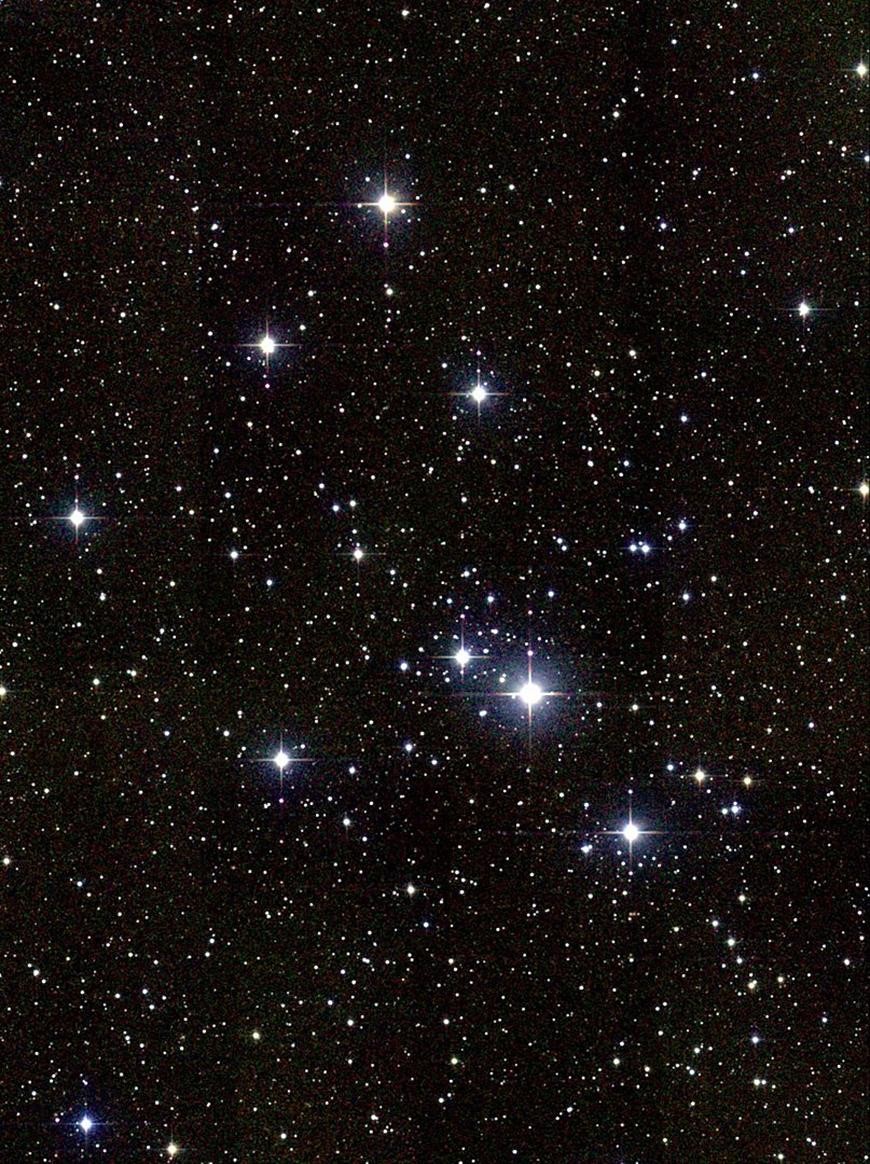
M41. Image credit: 2Mass (Two Micron All Sky Survey, University of Massachusetts & the Infrared Processing and Analysis Center/California Institute of Technology, funded by NASA and the National Science Foundation). Public Domain.
The nearby +2.59 mag asterism or very loose and ill-defined open cluster Collinder 121, which can be found under a degree to the E of Omicron Canis Minoris, is thought to share a similar proper motion with M41, indicating a possible common origin for both objects. Both clusters lie around 60 light years from one another, so this is also indicative of a possible relationship.
Some 9 degrees to the NW of M41 lies yet another open cluster, NGC2360. Though not quite as bright or as large as some of its more illustrious and well-known neighbours, the is cluster is an attractive +7.19 mag, 13 arc minute diameter object. It was discovered by Caroline Herschel, sister of William, who was a very skilled and methodical observer and astronomer in her own right - and a great organiser and cataloguer of her brother's work. This is significantly thought to be her first independent discovery, though included on her own Deep Sky list as number 2. There are more than 100 stars of observable magnitude packed into this compact areas, of which the Western section is more populous than the Eastern half. There are many fine chains and voids within this cluster and it can easily be found in binoculars and smaller telescopes. It is probable that this cluster would be more conspicuous were it not appearing to merge with the Milky Way to its Southern reaches. The rich star clouds of our background galaxy appear to somewhat swamp NGC2360 in this area. NGC2360 is thought to be around 6100-6200 light years away.
Two 1/2 degrees to the N of NGC2360 lies the impressive complex of nebulosity known variously as Thor's Helmet, the Duck Nebula, or more properly, NGC2359.
This area of sky is a perennial favourite or astrophotographers, as long duration photos reveal this bubble of gas and surrounding filaments well. However, a decent OIII filter will reveal much of this to visual observers with reasonable-sized telescopes. At +11.5 mag, it may appear to the uninitiated that Thor's Helmet isn't particularly bright, and while this is true, at 8 x 6 arc minutes across, it is compact, which helps keep the surface brightness up somewhat. As mentioned, appropriate filtration helps immeasurably with observations of NGC2359, which reveals its U-shaped main arc, with what looks like a faint circular planetary nebula lurking at its bottom. This central bubble-like feature forms the "Helmet", with the "Horns" of nebulosity either side - to this observer, it looks much more like the titular helmet than the otherwise associated wildfowl! The spheroid feature in the centre is caused by the ferocious stellar wind from a central star, a Wolf-Rayet giant, which is in the final stages of burning all of its nuclear fuel before collapsing as a Supernova. When, inevitably, this star does die, it will be a spectacular event, though lying some 15000 light years away will not present us with any difficulties here on Earth.
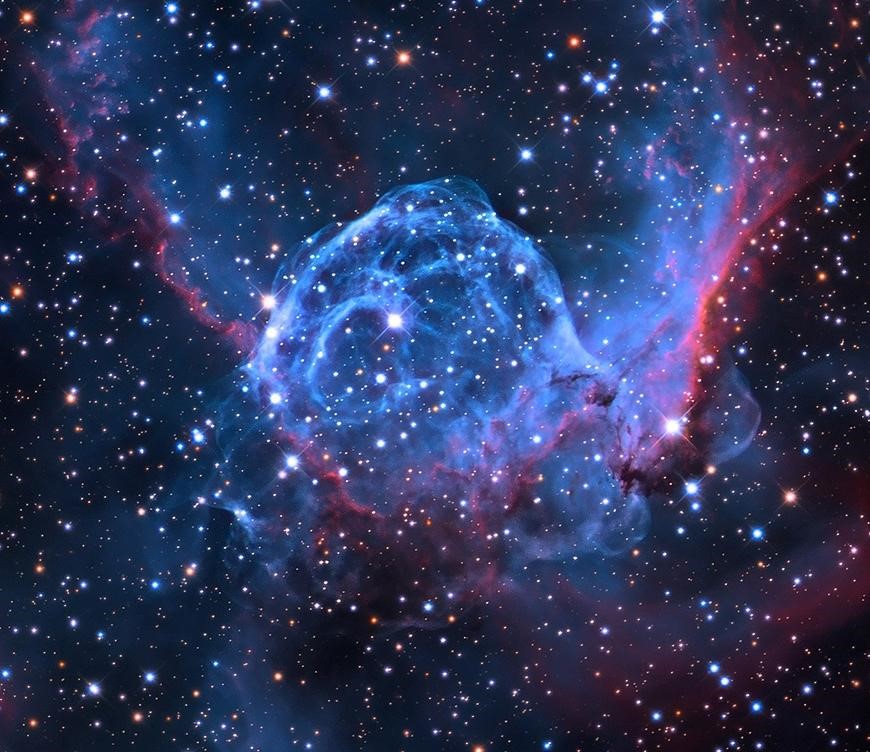
Naturally, we could not leave this month's journey around Canis Major without mentioning its most obvious feature, Alpha Canis Majoris and the brightest in the sky (after the Sun) - otherwise familiar to all as Sirius, or the Dog Star . The name Sirius derives from the Ancient Greek for "scorching" or "searing" - and we can certainly see why. At -1.46 mag it is well in excess of its nearest rival, Canopus in Carina, which only manages a "feeble" -0.62 mag in comparison!
Sirius is an A1 V class star, a white main sequence star with a surface temperature of around 9900 Kelvin. In comparison the Sun's mean surface temperature is around 5770K - so Sirius is most definitely the hotter and more energetic of the two. Sirius is nearly twice the size and over twice the mass of our Sun and considerably younger, as evidenced by the larger Iron content of its spectral signature. While Sirius is larger and brighter, the reason for its brightness is simple - it is pretty close by cosmic standards, just 8.58 light years away from us. Being so close, Sirius has a very large proper motion through the sky, which was discovered by Halley in the 17th Century. Halley studied Ptolemy, the Ancient Greek/Egyptian Astronomer's maps and by comparing the relative position of Sirius in these, in comparison to that of the time, found that the Dog Star had shifted position by half a degree - nearly the diameter of the Moon. Sirius is moving in a southerly direction at around 1.3 seconds of arc a year. It is also blue-shifted in its spectrum, meaning it is moving towards our Solar System at a closing speed of 7.6km per second. Indeed, it was the first star to be measured for this in 1868. Sirius also shares its proper motion with a number of nearby stars, including the central stars in The Plough (or Big Dipper): Merak, Phecda, Alioth, Megrez and Mizar. Interestingly, these are all relatively young A-type stars - possibly suggesting a common birthplace - though this is by no means certain.
The motion of Sirius was much-studied during the 19th century and was observed to have something of a regular deviation. This could most logically be explained by an unseen companion star. The search was on - but Sirius being so bright masked its companion. It was not until 1862 that the companion star, nicknamed "The Pup" was seen by Alvan Graham Clarke, whilst star testing the freshly-installed 18.5-inch Refracting telescope at the Northwestern University Dearbourne Observatory in Illinois, USA. At the time, this telescope was the largest in the Americas - and this discovery is still a crowning achievement for this particular instrument. This discovery was later confirmed by smaller aperture telescopes. Later spectral analysis of Sirius B in 1915, via the Mount Wilson Observatory 1.5m reflector, led Astronomers to conclude that they were witnessing a White Dwarf star - only the second to be discovered (the first, 40 Erinadi B, was discovered as part of a multiple star system in 1783 by William Herschel, though not recognised as such at the time). Later radio observations from Jodrell Bank in the UK and other measurements carried out by a number of optical telescopes, including the Hubble Space Telescope have accurately measured Sirius B's diameter to a figure of 12,000 km or 7,500 miles - just under that of the Earth. Yet the spectral signature of Sirius B suggested a surface temperature of 24,800 K - far hotter than Sirius A. But Sirius B's orbit suggested a mass in excess of the Sun's - so what was this mysterious object? The most logical conclusion to this conundrum was the theory of White Dwarf evolution - which is now accepted as the common fate of most main sequence stars. After consuming all of their conventional nuclear fuel, stars like Sirius and our Sun eventually swell to a red giant stage and then shrug off their outer layers, which drift away into space as Planetary Nebulae. The core of the star is left to contract, not having the outward release of nuclear fusion to counteract the effect of gravity, which packs the star's leftover carbon and oxygen atoms ever more tightly until there is no more space left, even between atoms. This has the effect of increasing the surface temperature, though it takes a long time for the full energy of a White Dwarf to be released. It is thought that White Dwarf stars persist for billions of years in this state, until slowly they cool and fade. As a result of this atomic compression, a cubic inch of White Dwarf material is thought to weight an extraordinary 25 tons.
Observations of Sirius B can be made in telescopes of a surprisingly modest aperture - if conditions are right, experienced observers have claimed to see it at high powers with a 100mm telescope. The general consensus seems to be that 8-inch instrument using high magnification should be able to resolve it fairly straightforwardly under good conditions. It is recommended to keep magnification up around the 250-300x level and to ensure your telescope is properly cooled down and well acclimatised before any attempt is made. The brilliance of Sirius A can play havoc with attempts to resolve B, which at +8.43 mag is so much fainter. Orientation of the vanes of a Newtonian, producing inevitable diffraction spikes must be watched out for, as these will easily swamp B. As B appears almost due East of A, conventionally-mounted horizontal spider vanes of Dobsonians can be particular culprits from temperate latitudes (depending on the orientation of the system as it travels on its arc through the sky). In cases such as these, either putting Sirius just out of the field of view, or attempting to rig up an occulting bar, by blocking a section of the field lens of an eyepiece can work wonders. Those with unobstructed telescopes such as larger refractors and SCT-style instruments with supporting optical windows, rather than spiders, may fare more easily here. But everyone who owns a telescope should at least have a go at trying to observe the Pup. Those who find it will be satisfied they are observing an object less than the diameter of the Earth, 8.58 light years away - and currently separate from Sirius A by just 30 AU (roughly the distance from Earth to Neptune in our Solar System). Although there are other more easily visible White Dwarf stars, the Sirius A/B system, currently separated by 11.7 seconds of arc, remains great test of sky conditions, optical performance and observing skill - get out there and give it a go!
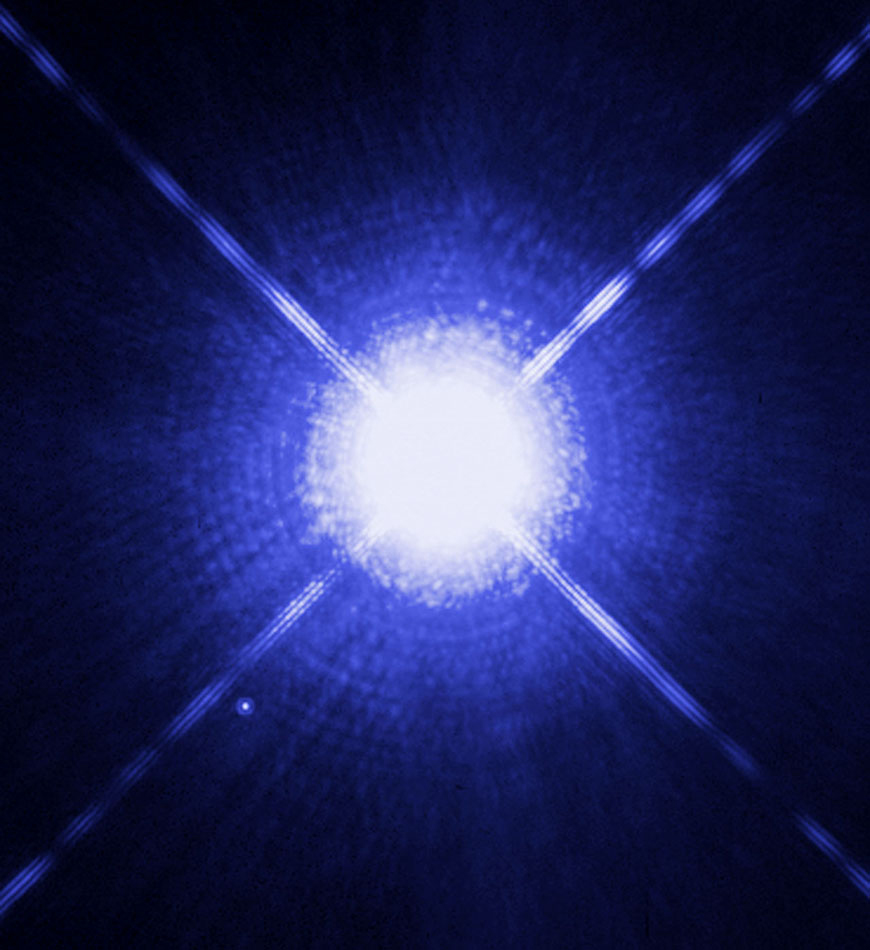
Controversially, Sirius was listed by Ptolemy as a definitely red star. He is very clear about this colour - as Antares in Scorpius and Betelguese in Orion are also members of this list. Both these stars are unambiguously red in colour, as they are both M2 class Red Supergiants. Sirius, in comparison, is anything but. It has been postulated that during Ptolemy's era, Sirius may have been obscured by a cloud of interstellar dust or nebulosity - of which the nearby NGC2327 nebula is the prime candidate. However, this explanation seems rather far-fetched. Another theory is that there is a further, unseen Red Dwarf star which is some way caused some occultation event of Sirius and led to the change in colour. Although there is some proper motional evidence that there is a third, as yet unseen, companion in the Sirius system, no direct observational evidence has supported this theory. With the sensitivity and resolutional ability of modern telescopes, it is unlikely we would have to have waited this long for confirmation of this third member of the Sirius family. However, a more prosaic explanation for Ptolemy's description exists - during ancient times, the appearance of Sirius above the horizon, just before dawn, as observed from Egypt, marked the start of the Nile's annual flood - an event of extreme significance to Egyptian agriculture, science and culture. When Sirius is observed in such a manner, just as atmospheric refraction causes the Sun to appear red at dawn and sunset, an object as bright as Sirius can appear with a distinctly reddish hue. Maybe this is the cause of the so-called "Red Sirius Mystery"?
Original Text: Kerin Smith

 English
English